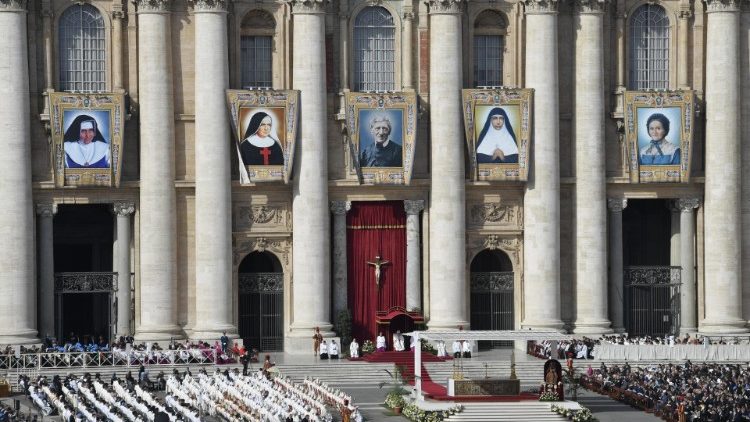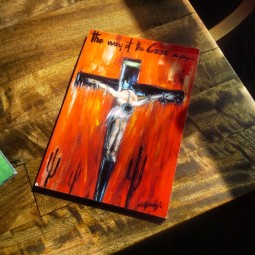
Today, four women and one man were canonized as new saints – we all know about the man (more about him at the end of this post) – how about the women?
Not long after joining the missionary sisters, Dulce became determined to shelter the many ill people she encountered on the streets of Salvador. She would house them in abandoned buildings and bring them food and medical care.
Eventually she and her more than 70 patients were kicked out of the building. Left with nowhere to take them, she asked her mother superior for help, and was given the convent’s chicken yard to turn into an improvised hotel.
As part of the agreement, Sr. Dulce was asked to care for the chickens, which she did by butchering them and feeding them to her patients.
This eventually became the site of the Santo Antonio Hospital, which continues to serve Brazil’s poor and disabled.
Bl. Dulce founded the Sao Francisco’s Worker’s Union, the first Christian worker’s movement in the Brazilian state of Bahia, which she later transformed into the Worker’s Center of Bahia.
She also founded the Charitable Works Foundation of Sister Dulce (Obras Sociais Irma Dulce) in 1959, which continues to be one of the most well-known and well-respected charitable organizations in Brazil.
In 1988, Sr. Dulce was nominated for the Nobel Peace Prize by the President of Brazil, Jose Sarney.
She died in 1992, at the age of 77, after battling lung problems for 30 years.
From the homily at her 2011 beatification Mass, by Cardinal Geraldo Majella:
Thus today we contemplate the holy life of Sister Dulce, with all the fruits in favor not only those lacking everything, especially health, but also as witness of her union with God, across the hearing and contemplation of his Word and of daily communion of his Body and his Blood in the celebration of the Eucharist that is the offering of the redemptive sacrifice of Christ the celestial Father.
But dear brothers and sisters, living holiness as I have already said not is the privilege for some person, but it is the duty of all baptized Christians. In the first Letter of Peter 1:15-16, the apostle tells us: “As he is holy that calls you, making you saints, also you in your conduct. For it is written: ‘Be holy because I am holy’ (Lv 11:44ss; 19:2)”. The Word of God does not say some, but all that hear the Word of God, converted themselves in following Jesus.
Some stand out more clearly by a special gift to become an example and challenge to society that lives without caring about the disadvantaged and needy. Sister Dulce was privileged in thisrespect, not to put limits on the Love of God and neighbor.
In 1853, when she was 35, Marguerite was operated on for intestinal cancer. The treatments were very invasive, and she prayed to Our Lady for healing and for a different understanding of suffering.
When Pope Pius IX proclaimed the dogma of the Immaculate Conception, on 8 December 1854, both of her prayers were answered. From then on, Marguerite was forever bound to the figure of the suffering Christ on the cross.
She developed the stigmata, the crucifixion wounds of Jesus, on her hands, feet and chest. At first she kept it secret, but the news soon leaked out. On Fridays and during Holy Week, she would fall ill or experience moments of ecstasy. Gradually the pain became more and more intense, and on 27 June 1879, Marguerite died.
John Paul II’s homily at her 1995 beatification:
Some of her contemporaries found that her long moments in prayer were a waste of time. But, more her prayer was intense, more she approached God and more she was devoted to serving her brethren. For, only he who prays really knows God and, by listening to the heart of God, he is also close to the heart of the world.
Thus we discover the important place of prayer in secular life. It does not drive one away from the world. On the contrary, it enlarges the internal being, it opens one to forgiveness and fraternal life.
The mission lived by Marguerite Bays is the mission which behoves to each Christian.
In catechism, she endeavoured to present to the children of her village the message of the Gospel, using words that the young could understand. She devoted herself generously to the poor and the sick.
Without leaving her country, she had nevertheless an open heart towards the dimensions of the universal Church and the world. With the missionary spirit which characterised her, she implanted in her parish the Propagation of the faith and of the Holy Childhood.
In Marguerite Bays, we discover what Our Lord did to make her achieve saintliness: she walked humbly with God, in accomplishing each action in her daily life with love.
Giuseppina Vannini is a 19th century religious sister from Rome known for founding the congregation of the Daughters of St. Camillus dedicated to serving the sick and suffering. She is the first Roman woman to be canonized in more than 400 years, according to ACI Stampa.
Vannini spent much of her childhood in an orphanage near St. Peter’s Square after losing her father when she was four, and her mother when she was seven. She grew up among the Daughters of Charity sisters, who ran the orphanage. On the day of her first communion, young Giuseppina felt that she was called to a religious vocation.
This desire was not realized until 1892 when she was 33 because she was rejected by the Daughters of Charity after her novitiate due to her poor health.Despite her own health problems, Vannini went on to found the Daughters of St. Camillus, whose charism is to serve the sick, even at the risk of their own lives. However she did not live to see the congregation fully recognized by the Vatican. She died at the age of 51 in 1911.]
Mother Mariam Thresia (1876-1926) was an Indian mystic and founder of the Congregation of the Holy Family. Her prayer life was characterized by frequent ecstasies in which she would sometimes levitate above the ground. In 1909, Thresia received the stigmata, after which she also suffered from demonic attacks.
Mother Thresia cared for the poor, sick, and dying in Kerala, visiting those with leprosy and measles. She also preached to the poor and the rich alike the importance of happy, healthy families to uplift all of society. In 1914 Thresia founded the Congregation of the Holy Family, which has grown to have 176 houses around the world with 1,500 professed sisters.
Cardinal Newman is featured in Bishop Robert Barron’s Pivotal Players series. I wrote a prayer/meditation companion book for the series Praying with the Pivotal Players. Below are pages from a chapter on “The Idea of the University.” Note that this book is designed to aid the reader in personal reflection, so the chapter leads from Newman’s general points to suggestions on how his thought in this area might lead and challenge us in our spiritual growth.
Here is a website dedicated to Mother Mariam Thresia
John Paul II’s homily at her 2000 beatification.
“Unless a wheat grain falls on the ground and dies, it remains only a single grain; but if it dies it yields a rich harvest” (Jn 12: 24). From childhood, Mariam Thresia Mankidiyan knew instinctively that God’s love for her demanded a deep personal purification. Committing herself to a life of prayer and penance, Sr Mariam Thresia’s willingness to embrace the Cross of Christ enabled her to remain steadfast in the face of frequent misunderstandings and severe spiritual trials. The patient discernment of her vocation eventually led to the foundation of the Congregation of the Holy Family, which continues to draw inspiration from her contemplative spirit and love of the poor.
Convinced that “God will give eternal life to those who convert sinners and bring them to the right path” (Letter 4 to her Spiritual Father), Sr Mariam devoted herself to this task by her visits and advice, as well as by her prayers and penitential practice. Through Bl. Mariam Thresia’s intercession, may all consecrated men and women be strengthened in their vocation to pray for sinners and draw others to Christ by their words and example.
7. “I will be their God, and they shall be my people” (Jer 31: 33). God is our only Lord and we are his people. This indissoluble covenant of love between God and humanity was brought to its fulfilment in Christ’s paschal sacrifice. It is in him that, despite belonging to different lands and cultures, we become one people, one Church, one and the same spiritual building whose bright and solid stones are the saints.
Pope Francis’ homily from today:
To cry out. To walk. To give thanks. Today we give thanks to the Lord for our new Saints. They walked by faith and now we invoke their intercession. Three of them were religious women; they show us that the consecrated life is a journey of love at the existential peripheries of the world. Saint Marguerite Bays, on the other hand, was a seamstress; she speaks to us of the power of simple prayer, enduring patience and silent self-giving. That is how the Lord made the splendour of Easter radiate in her life. Such is the holiness of daily life, which Saint John Henry Newman described in these words: “The Christian has a deep, silent, hidden peace, which the world sees not… The Christian is cheerful, easy, kind, gentle, courteous, candid, unassuming; has no pretence… with so little that is unusual or striking in his bearing, that he may easily be taken at first sight for an ordinary man” (Parochial and Plain Sermons, V, 5).
Let us ask to be like that, “kindly lights” amid the encircling gloom. Jesus, “stay with me, and then I shall begin to shine as Thou shinest: so to shine as to be a light to others” (Meditations on Christian Doctrine, VII, 3). Amen.
As I’ve mentioned before, Cardinal Newman is featured in Bishop Robert Barron’s Pivotal Players series. I wrote a prayer/meditation companion book for the series Praying with the Pivotal Players. Below are pages from a chapter on “The Idea of the University.” Note that this book is designed to aid the reader in personal reflection, so the chapter leads from Newman’s general points to suggestions on how his thought in this area might lead and challenge us in our spiritual growth.
There are four more chapters on Newman in the book.
More Newman in a book I’ve had a hand in:
Benedict XVI’s homily at the beatification Mass for Newman:
While it is John Henry Newman’s intellectual legacy that has understandably received most attention in the vast literature devoted to his life and work, I prefer on this occasion to conclude with a brief reflection on his life as a priest, a pastor of souls. The warmth and humanity underlying his appreciation of the pastoral ministry is beautifully expressed in another of his famous sermons: “Had Angels been your priests, my brethren, they could not have condoled with you, sympathized with you, have had compassion on you, felt tenderly for you, and made allowances for you, as we can; they could not have been your patterns and guides, and have led you on from your old selves into a new life, as they can who come from the midst of you” (“Men, not Angels: the Priests of the Gospel”, Discourses to Mixed Congregations, 3). He lived out that profoundly human vision of priestly ministry in his devoted care for the people of Birmingham during the years that he spent at the Oratory he founded, visiting the sick and the poor, comforting the bereaved, caring for those in prison. No wonder that on his death so many thousands of people lined the local streets as his body was taken to its place of burial not half a mile from here. One hundred and twenty years later, great crowds have assembled once again to rejoice in the Church’s solemn recognition of the outstanding holiness of this much-loved father of souls. What better way to express the joy of this moment than by turning to our heavenly Father in heartfelt thanksgiving, praying in the words that Blessed John Henry Newman placed on the lips of the choirs of angels in heaven:
Praise to the Holiest in the height
And in the depth be praise;
In all his words most wonderful,
Most sure in all his ways!
(The Dream of Gerontius). .…more


























